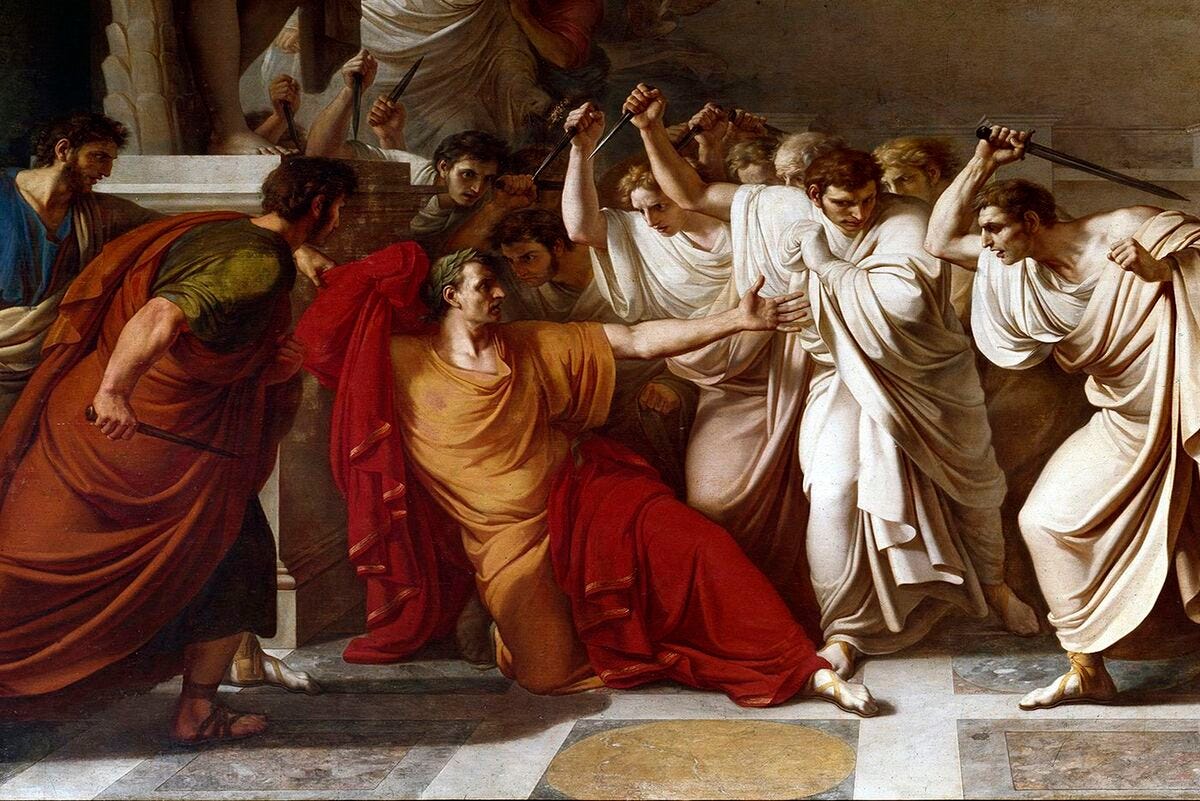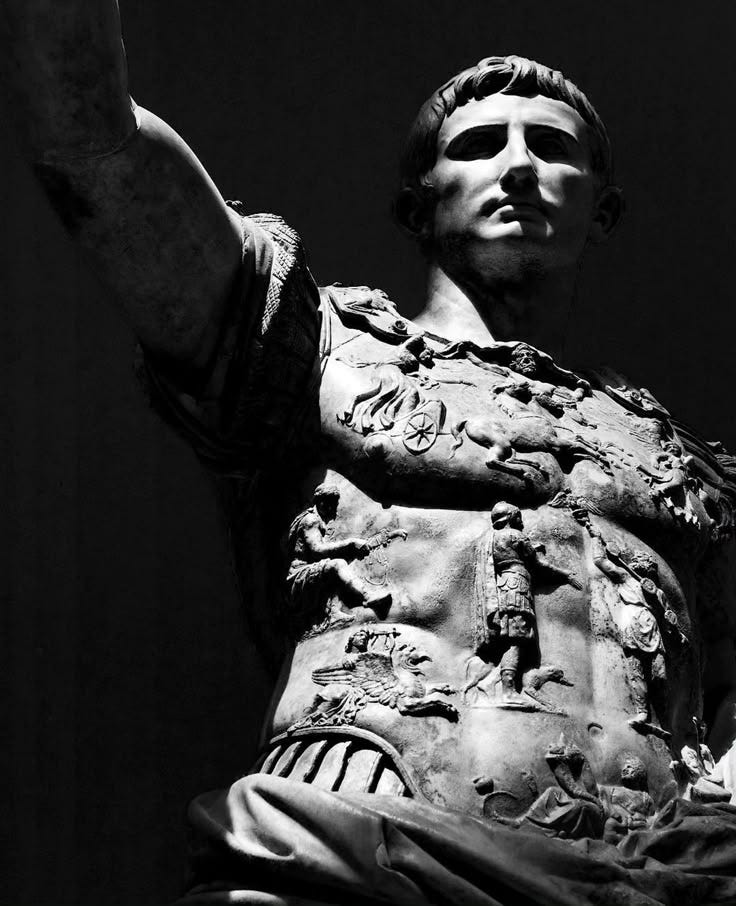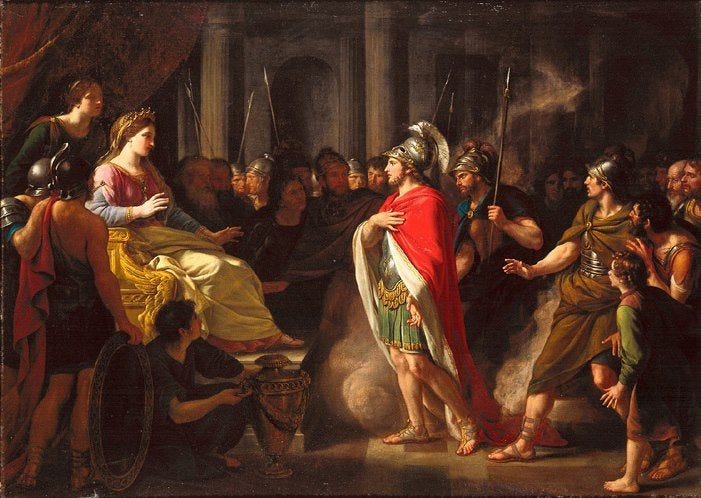The Aeneid was composed in Latin in dactylic hexameter, the homeric epic meter, by the Roman poet, Virgil. Publius Virgilius Maro is the first author in this course who we know a fair bit about. Virgil lived through what must be the most remarkable period in Roman history—Caesar’s ascent to power, the ensuing civil wars, and Rome’s transition from a republic to an empire. These events significantly influenced his composition of the Aeneid, which is not just a continuation of the Greek epic narrative, but a political and nationalistic work.
Virgil was born in 70 BC in Cisalpine Gaul in Northern Italy. Until 89 BC, the various Italic tribes which were allies of Rome, such as those in Cisalpine Gaul, and many others throughout Italy, did not have Roman citizenship, which was then exclusive to the citizens of the Roman Republic. During The Marsic War (91-88 BC), these tribes formed a union and rebelled against Rome, setting up their own republic, which they called Italia. They established a capital in Corfinium, not far from Rome, created a senate and army, and even printed special coinage for their state. In the ensuing war, Rome achieved victory, but Roman citizenship was granted to all the Italian peoples south of the Po River.
This means that when Virgil was born, he was not a citizen of Rome. It was Julius Caesar who, during his accumulation of power in Gaul, granted citizenship to the Italians north of the Po River in 49 BC, when Virgil was 21 years old.
From 49 to 45 BC, Caesar fought a civil war with Pompey, achieved victory, and declared himself dictator. In 44 BC, Caesar was assassinated, and another civil war ensued, with Caesar’s top general, Mark Antony, and his great-nephew and adopted son, Octavian, on one side, and the pro-republican conspirators, Brutus and Cassius on the other. The republicans were defeated and Octavian and Mark Antony were left in control over Rome.
During this time, Virgil published his first work, Eclogues, a collection of pastoral poems which caught the attention of Maecenas, a close friend of Octavian. Around this time he also began composing his second popular work, Georgics, a four-book work about farming, inspired by Hesiod’s Works and Days (circa. 700 BC).
Mark Antony had been married to Octavia, Octavian’s sister, but he left her and their children to resume his affair with Cleopatra, Queen of Egypt. The growing tensions between Octavian and Mark Antony culminated in the Battle of Actium in 31 BC, where Mark Antony was defeated.
Following his victory, Octavian had sole claim to Rome and became the first Roman Emperor, taking on the title of Augustus. By this time, Octavian and Virgil were close acquaintances, and Virgil began his composition of the Aeneid, a Roman national epic. However, in 19 BC, he fell ill and died, with the epic still an unedited draft. He allegedly ordered the Aeneid to be destroyed, but Augustus had it finalized and published.
NARRATIVE OVERVIEW
The Aeneid is a direct continuation of the Trojan War narrative. It follows Aeneas, a Trojan hero featured in the Iliad, as he leads the remainder of the Trojans who escaped Troy across the Mediterranean to the promised land of Italy, where they are destined to found a new civilization: Rome. The idea that Aeneas fled to Italy after the Trojan war was a well established folk tradition, at least dating back to the 5th century BC, but it is not mentioned in the Iliad, Odyssey, or, as far as we know, any of the shorter lost epics.
The structure and style of the Aeneid closely imitate homer, with the first six books of the Aeneid emulating the themes and structure of the Odyssey, and the final 6 books emulating the themes and structure of the Iliad.
The narrative begins with Aeneas’ fleet being accosted by a storm sent by Juno (the Roman Hera), and washing up on the shores of Libya. Aeneas’ mother, Venus (the Roman Aphrodite), then appears to him in disguise and reminds him of his fate—to found a new Troy on Italian soil. Juno, who, along with Athena, was on the side of the Greeks in the Trojan War, plays the same role in the Aeneid that Poseidon did in the Odyssey, while Venus, who was on the side of the Trojans, plays a similar role to Athena.
In this narrative, Juno favors the Carthaginians, whose shore Aeneas’ fleet has washed up on. Carthage was a Phoenician civilization in North Africa which competed with Rome for control over the Mediterranean in a series of wars which lasted from 264 to 146 BC. These were the Punic Wars, during which the famous Hannibal even crossed the Alps, invading Italy directly. The third Punic War culminated in Romes victory and the total annihilation of Carthage. And this historical context is woven into the Aeneid. Juno wants her Carthaginians to have rule over the Mediterranean, and therefore wants to prevent Aeneas from reaching Italy and founding the civilization which will one day wipe out her favorite people.
Aeneas is welcomed hospitably by Dido, queen of the Carthaginians, and she asks him to recount his story. Aeneas then recounts the sack of Troy by the Greeks, which overlaps with the end of the Posthomerica, which had not yet been composed, and his subsequent wanderings through the Mediterranean, in search of a new homeland upon which to build a new Troy. This of course imitates Odysseus’ retelling of his wanderings to the Phoenicians in the Odyssey. On his wanderings, Aeneas and his crew encounter the blinded Polyphemus, sail by Scylla, Charybdis, and the Sirens, and encounter the Harpies, who are featured in Apollonius of Rhodes’ Argonautica (circa 240 BC), which I will discuss in the conclusion of the Greco-Roman section of the course.
Aeneas enters a romance with Dido and stays in Carthage for a while, but he ultimately must leave her behind to seek out Italy, his future homeland, just as Odysseus had to leave Circe and Calypso for his home and wife. Aeneas and Dido’s doomed love sets up the future conflict between the Romans and Carthaginians. It also mirrors the doomed love of Jason and Medea in the Argonautica.
In book six of the Aeneid, Aeneas travels to the underworld in a greatly elaborated version of Odysseus’ conjuring of the dead, where the ghost of his father show him the glory of Rome and his future descendants, including Augustus. This book is what inspired Dante’s Inferno, in which Dante is guided through hell by the ghost of Virgil.







